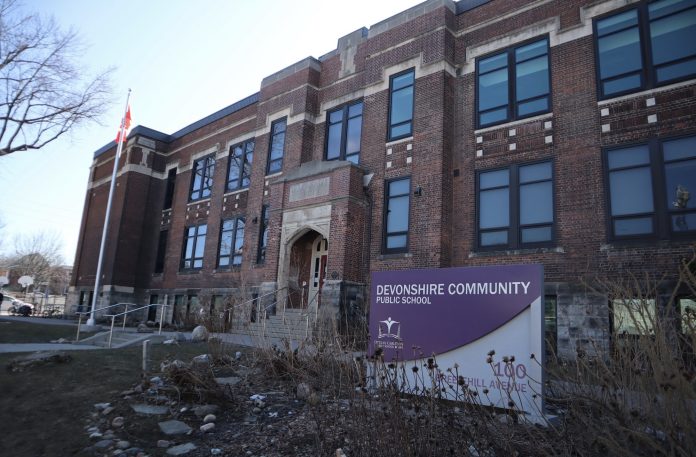The Ottawa Carleton District School board is in a tough financial spot. It is facing a $20 million budget shortfall for the 2025-26 school year and has no money left in its reserves. To make matters worse, this is the fourth consecutive deficit it has posted.
As a result, some tough decisions need to be made, said OCDSB executive director Pino Buffone. The public board has plans to change its map boundaries, impacting 123 schools. That would see about 11,000 students need to switch educational facilities by September 2026, which is 5,000 more than in a normal year. A total of 30 schools would see grade reconfigurations.
Parents say this would cause a lot of complications. Laura D’Angelo’s 4-year-old son Finn currently attends the French Immersion Junior Kindergarten program at Broadview Public School. But when it’s time for her now 1-year-old daughter to start school, she will need to attend Churchill Alternative for French Immersion.
“They are equidistant from my house but completely opposite directions. Churchill is an alternative school and the board has committed to phasing out alternative education, making all grades available for eight years so they can finish out the program they’ve selected,” said D’Angelo. “That means in 2026, when my son will be in Grade 1, Churchill will not offer French immersion so he has to stay at Broadview. But my daughter, who will go to school in 2028, has to go to the new school she’s zoned in because they don’t offer crossboundary transfers right now.”
Kate Purchase’s family is in a similar boat. She was “shocked” to see her kids would be impacted by the boundary changes, because they live so close to Broadview School.
“What we discovered was that only our side of the street and only our block of the street was going to be zoned out of the Broadview catchment, which meant that our daughter would not be able to go to Broadview with our son who would get grandparented into the school,” Purchase said.
When it’s her daughter’s time to start public education, she will now need to attend Churchill between Kindergarten and Grade 6, Fisher Park Public School — a 40-minute walk away — for Grades 7 and 8, and then a final jump to Nepean High School for the last four years.
Another educational facility that will see drastic changes is Woodroffe Avenue Public School near Carlingwood Mall. Elizabeth MacDonald’s two kids are enrolled there and live only 350 metres from the school. But new changes will split them apart.
”We have a thriving Kindergarten to Grade 8 school in a beautiful diverse and mixed demographic neighborhood. One of the things we love most about our community school is the diversity within it. Unfortunately, under the elementary program review proposal, my 8-year-old will remain at Woodroffe because he will be grandfathered under the current plan because it is becoming a Grade 4 to 8 school. My 4-year-old will unfortunately travel about three kilometres to Regina Street School.”
That school will be at 124 per cent capacity. Four other OCDSB schools which are closer to MacDonald’s family will be under capacity. The changes would also mean her daughter needs to change schools three times before grade 4.
“I walk my kids to and from school and I don’t think I will be able to logistically make that happen any longer,” said MacDonald. ”I would rely on the after-school program if we can get a spot and I would need to go walk to pick her up from there. But walking six kilometres on a -30 C day in the dark winter along Richmond Road with the construction that is projected to continue for decades seems illogical.”
Students who attend Devonshire Public School will also face negative impacts. They will be split between four schools with the three others being Cambridge, Centennial and Mutchmor.
Simmi Dixit, whose child attends Grade 1 at Devonshire, would like to see existing students grandfathered and changes made to the boundary radius.
“Displacing children and placing them in new schools, changing their commute, their peers and their teachers all at once is a huge shock. For children in grade 3 or 4, this change would happen two years in a row, as they move once in 2026 and again as they enter into Grade 7,“ Dixit told trustees. “The research indicates that these kinds of disruptions can lead to increased anxiety, decrease in school performance, greater duress for educators and school systems and absenteeism in high school.”
The OCDSB planned to release a report after KT went to print which would address “some of the concerns that have been raised” about proposed boundary and program changes.
Executive director Buffone said, “It won’t be perfect, but I’m very convinced that our planners continue to work on areas that have been addressed to try and alleviate some of the concerns that have been raised.”
